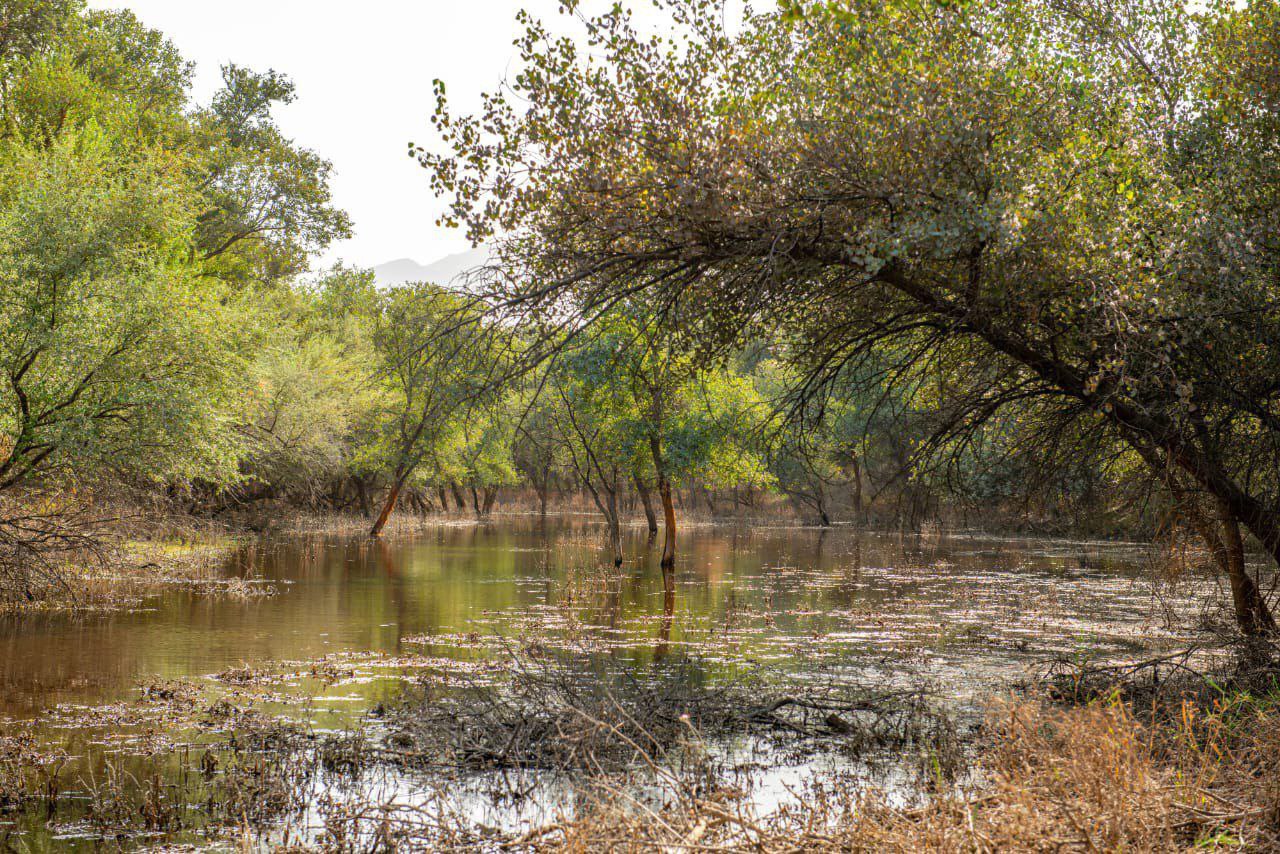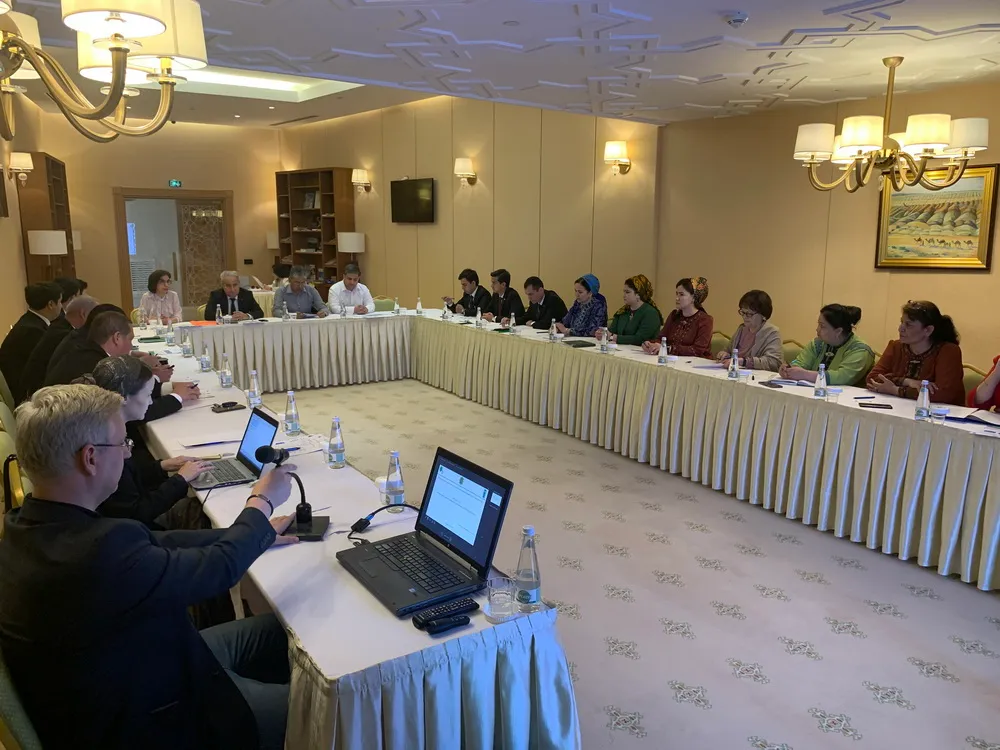Experts believe that this reserve is the only place in the world where tugai jungle has been preserved.
 “Tiger Beam”
“Tiger Beam”The first nature reserve in Tajikistan, Tigrovaya Balka, was created on November 4, 1938. In September 2023, the Tugai forests of the Tigrovaya Balka Nature Reserve were included in the UNESCO World Heritage List. Tajik experts hope that the inclusion of the Tigrovaya Balka Nature Reserve on this List will allow it to be preserved.
After all, this reserve, according to experts, is the only place in the world where tugai jungle has been preserved.
The Tigrovaya Balka Nature Reserve is located in the valley of the Vakhsh River. At the beginning of the 20th century, there were tugai forests that resembled a real jungle of thickets of turanga (poplar), oleaster, various shrubs, tall grasses, lianas and meadows, writes Cabar.asia
In the 30s of the last century, due to the development of the Vakhsh Valley, the area of natural complexes was increasingly reduced.

Then the authorities decided to create the Tigrovaya Balka nature reserve here to preserve the natural complex characteristic of the southern deserts and floodplains of Central Asia, protect rare animals and conduct diverse scientific research.
In subsequent years, the territory of the reserve was expanded to its present state.
Last one on the planet
According to a researcher at the Institute of Zoology and Parasitology named after. E.N. Pavlovsky NAST Faridun Rakhimov, now the total area of the reserve is about 50 thousand hectares of territory. It covers a vast area of tugai ecosystems along the banks of the Vakhsh River, sections of the hilly sandy Kashka-Kum desert, the Buritau Mountains, as well as the lowlands of the southern spurs of the Aruktau ridge – the Khoja Koziyon Mountains.
The reserve is directly adjacent on four sides to the peasant farms of the Jaikhun, Kabodiyon, Dusti and Shakhritus districts. Water bodies occupy 21.4% of the total area of the reserve.
According to the head of the department of terrestrial vertebrates at the Institute of Zoology and Parasitology. E.N. Pavlovsky NAST Rustam Muratov, the Tigrovaya Balka Nature Reserve is the last large reserve on the planet of unique communities of tugai flora and fauna.

Its only analogue is the Zeravshansky Nature Reserve in Uzbekistan, whose area is only about 4,000 hectares.
“The vast tracts of tugai that previously existed in Afghanistan and Iran, according to the latest data, have been almost completely destroyed, and in their place are agricultural lands,” says Rustam Muratov.
On September 20, 2023, at the 45th session of the UNESCO World Heritage Committee, the natural site of Tajikistan “Tugai forests of the Tigrovaya Balka Nature Reserve” was included in the World Heritage List.
Rustam Muratov is one of the authors of this nomination for the Tigrovaya Balka Nature Reserve. According to him, this became possible thanks to the successful two-year cooperation of the National Academy of Sciences of the Republic of Tatarstan, the Institute of Geography of the Russian Academy of Sciences, the Committee for Environmental Protection under the Government of the Republic of Tajikistan and the Foundation for the Protection of Natural Heritage with the support of the UNESCO Cluster Office in Almaty.

According to experts, the status of a World Heritage Site, combined with its environmental significance, makes it possible to obtain many positive aspects both for the environmental aspect and for national support of the reserve.
“Tiger Beam” without tigers
In the first years of the creation of the reserve, Turanian tigers still roamed here. However, now these animals are not in the reserve. In Uzbekistan and Kazakhstan, the last time Turanian tigers were seen was in 1947, in Turkmenistan in 1953, in Tajikistan in 56.
In 1970, the Turanian tiger was officially declared extinct. Genetically, the Turanian tiger was very similar to the Amur tiger, which in turn lives in the Far East.
According to experts, the main reason for the disappearance of tigers was the violation of their habitat and direct persecution. Despite the fact that the Turanian tiger could not be saved, the name of the reserve was not changed.
The tugai forests where the tiger lived were intensively developed and turned into cotton fields. According to some data, in the 30s of the last century, tugai forests occupied an area of more than 90 thousand hectares, and twenty years later they were reduced by more than three times. And this is outside the territory of Tigrovaya Balka.

According to Abdullo Davlatov, associate professor of the Department of Ecology, Faculty of Biology, Tajik National University, in the 60s, the first director of the Tigrovaya Balka reserve, already an elderly general at that time, Aleksandrov, told him that in March 1949 he himself photographed the track of a Turanian tiger, and the tiger did not appear in this territory again.
Rustam Muratov says that in August 1970 he himself saw the tracks of a tiger in Tigrovaya Balka.
“In August 1970, in Tigrovaya Balka, I saw with my own eyes the tracks of a tiger. One day, when we were all in a local history group, a huntsman joined us and told us about finding traces of a big cat. He also covered the trail from possible damage. Moscow experts who arrived then confirmed that this was indeed the footprint of a Turanian tiger. Based on their research, it entered Tajikistan from the neutral territory of the border with Afghanistan, where large islands remained,” says Muratov.
Other rare animals of the reserve
According to Rustam Muratov, rare animals in the reserve include the Bukhara deer (over 300 individuals), goitered gazelle, striped hyena, and leopard (included in the IUCN Red Book). Of the fish: small Amu Darya pseudo-shovelnose, large Amu Darya pseudo-shovelnose, pike-shaped asp or balding fish, Aral and Turkestan barbel.
Among the reptiles: Central Asian steppe tortoise, several species of geckos, roundheads, foot and mouth disease, oriental boa, sand ephas, Central Asian viper, etc.
Mammals: little shrew, weasel, bandage, jungle cat, Indian porcupine, slender-toed ground squirrel, etc. Birds: white stork, great vulture, houbara bustard, black-bellied sandgrouse, vulture, griffon vulture, etc.

Faridun Rakhimov claims that in Tigrovaya Balka, birds hold first place in terms of diversity of species composition among all vertebrate animals of the reserve. The richest and most diverse avifauna is in tugai forests and floodplain lakes.
In the thickets of tugai forests you can find the black-and-gold or Tajik subspecies of the common pheasant. According to expert estimates by ornithologists, the reserve is home to 1200-1500 animals of this species. The reserve is a kind of genetic reserve of this type of pheasant for distribution throughout the Vakhsh Valley and the southern regions of the republic in general. In total, more than 240 bird species nest, winter, and migrate in the reserve.
“The Red Book of the Republic of Tajikistan and neighboring countries includes 55 species of rare and endangered bird species found in the reserve. These are small and great cormorants, red, gray and white herons, ospreys, gulls, terns, grebes, several species of waders and others,” Rakhimov noted.
Rustam Muratov is confident that the reserve is home to more than 60 species of rare and endangered vertebrates of Tajikistan and Central Asia.
The decoration of the reserve is the Bukhara (tugai) deer. This is the most beautiful subspecies of red deer, and it is not for nothing that in Central Asia it is called “hongul”, which means “royal flower”.
The flora of the reserve is also unique. Associate Professor of the Department of Ecology, Faculty of Biology, Tajik National University, Abdullo Davlatov, who has been studying the flora of Tigrovaya Balka since 1965, noted that in the flora of the reserve there are 764 species of flowering plants and 6 species of higher spore plants, belonging to 352 genera and 69 families.
Four species of plants grow exclusively on the territory of Tigrovaya Balka and are not found anywhere else.
According to him, valuable forage plants are 163 species (21.16%), technical plants (production of dyes, fibers, building materials, etc.) 52 species (6.75%), medicinal plants 125 species (16.23%) , ornamental plants 10 species (1.29%). There are more than 70 species of honey plants in the flora of the reserve (9.0%): more than 40 species (5.19%) are good sand stabilizers. The flora of the reserve also contains 19 species (2.46%) of poisonous plants.

How many lakes are there in the reserve?
There are more than a dozen lakes on the territory of the reserve. The length of the Tigrovaya Balka lakes can reach from 2 to 5-6 km, more often 3-4 km, and their width does not exceed 100-200 meters. The maximum depth in some areas of some lakes can reach 6.5-8 m. These are Darya-Kul and a group of lakes: Tukhloe, Kirpichnoe, Korchovoe, Bolshoye and Maloe Gulikovskoye. The water in them is brackish. The irrigation canals of the Dusti region flow here.
5-7 km downstream there is a second group of lakes: Podkovye, Bazovskoye and several more nameless swampy lakes.

The lakes of Tigrovaya Balka are the wintering grounds for more than 85 species of water and fish-eating birds. They fly here from Northern Kazakhstan, Kyrgyzstan and Western Siberia.
In “Tigrovaya Balka” there is a hunting lodge “Royal Dacha”, built in the Polvon-Tugai area in the early 60s. The Afghan king Muhammad Zahir Shah once came here to hunt. In honor of his arrival, this hunting lodge was built, and the name “Royal Dacha” remained.
Floods, pesticides and poachers threaten the reserve
According to experts, during its existence the reserve has been subjected to many tests. It was transferred from one department to another, lands were alienated and returned again, plowed up, cut down and restored, settled with refugees, military formations were stationed, etc. But the reserve still survived and continues to preserve unique tugai ecosystems to this day.
“A whole system of measures is needed to protect this wonderful natural complex. First of all, it is necessary to maintain the water regime, the rhythm of irrigation and flooding of the floodplain. If the floodplain is not flooded for 2-3 years or more, then the groundwater level under these soils drops to 3-5 meters, which leads to severe drying and salinization of the upper (1-2 m) layers of the soil, as a result of which the tugai vegetation dries out and is thinning out significantly,” says Abdullo Davlatov.
According to him, the main reasons for the existence of threats to the existence of the reserve are the massive development of lands adjacent to the border of the reserve, the lack of buffer zones, poaching, systematic forest fires, illegal grazing, lowering the water level in the Vakhsh River and illegal logging.
An extremely serious problem continues to be the unregulated discharge of wastewater from farmland, as well as the entry of various pesticides into the reservoirs of the reserve.
“Using the example of the Tigrovaya Balka reserve, it is necessary to show how important it is to revive the activities of other reserves, wildlife sanctuaries and national parks. Normalization of the work of all specially protected areas of Tajikistan is not only the preservation of valuable standards of nature, but also a serious improvement of the ecological environment,” said Abdullo Davlatov.
Source https://www.asiaplustj.info/ru/news/tajikistan/society/20240216/poslednii-oplot-tugainih-dzhunglei-smozhet-li-tadzhikistane-sberech-tigrovuyu-balku



